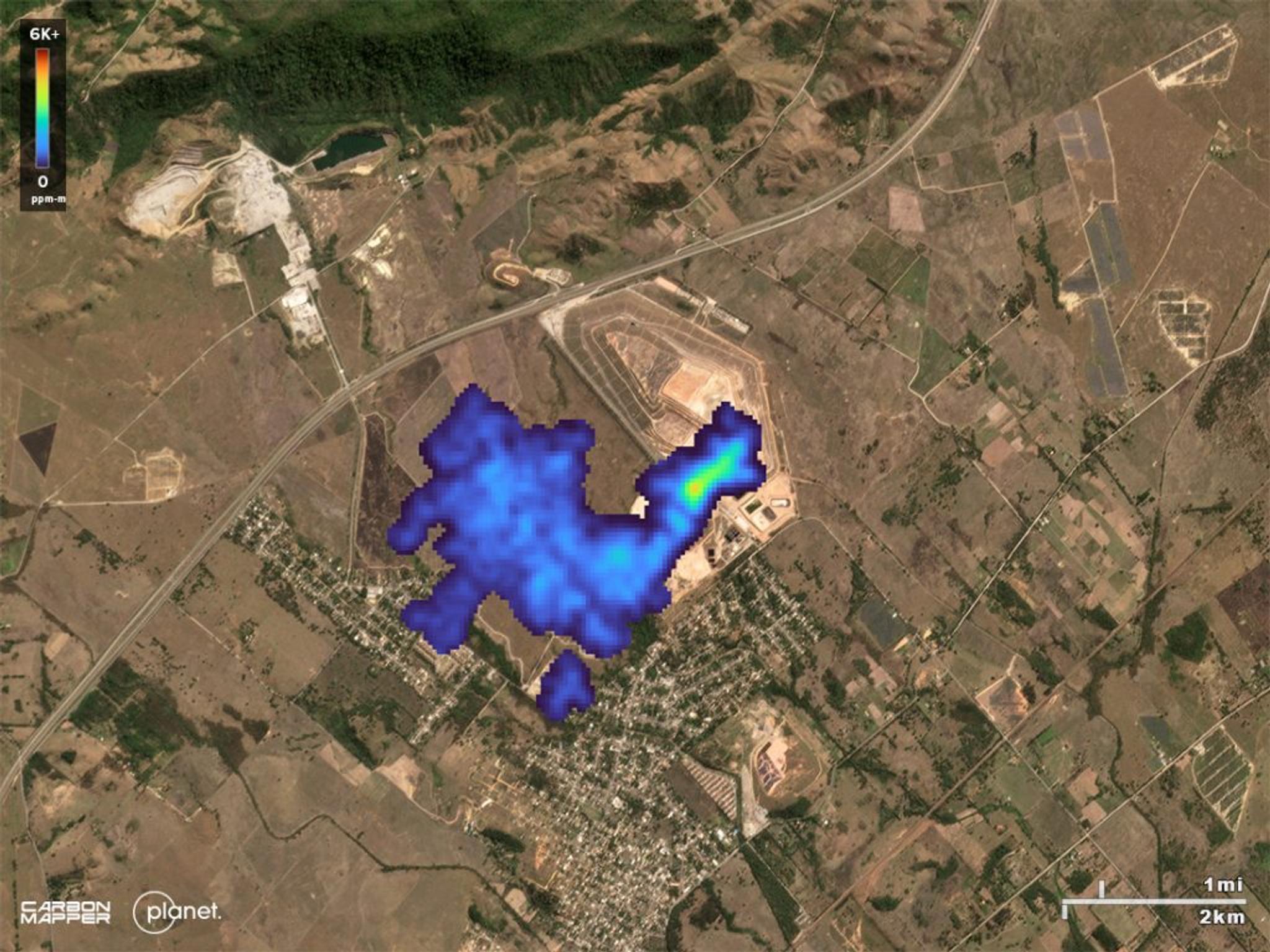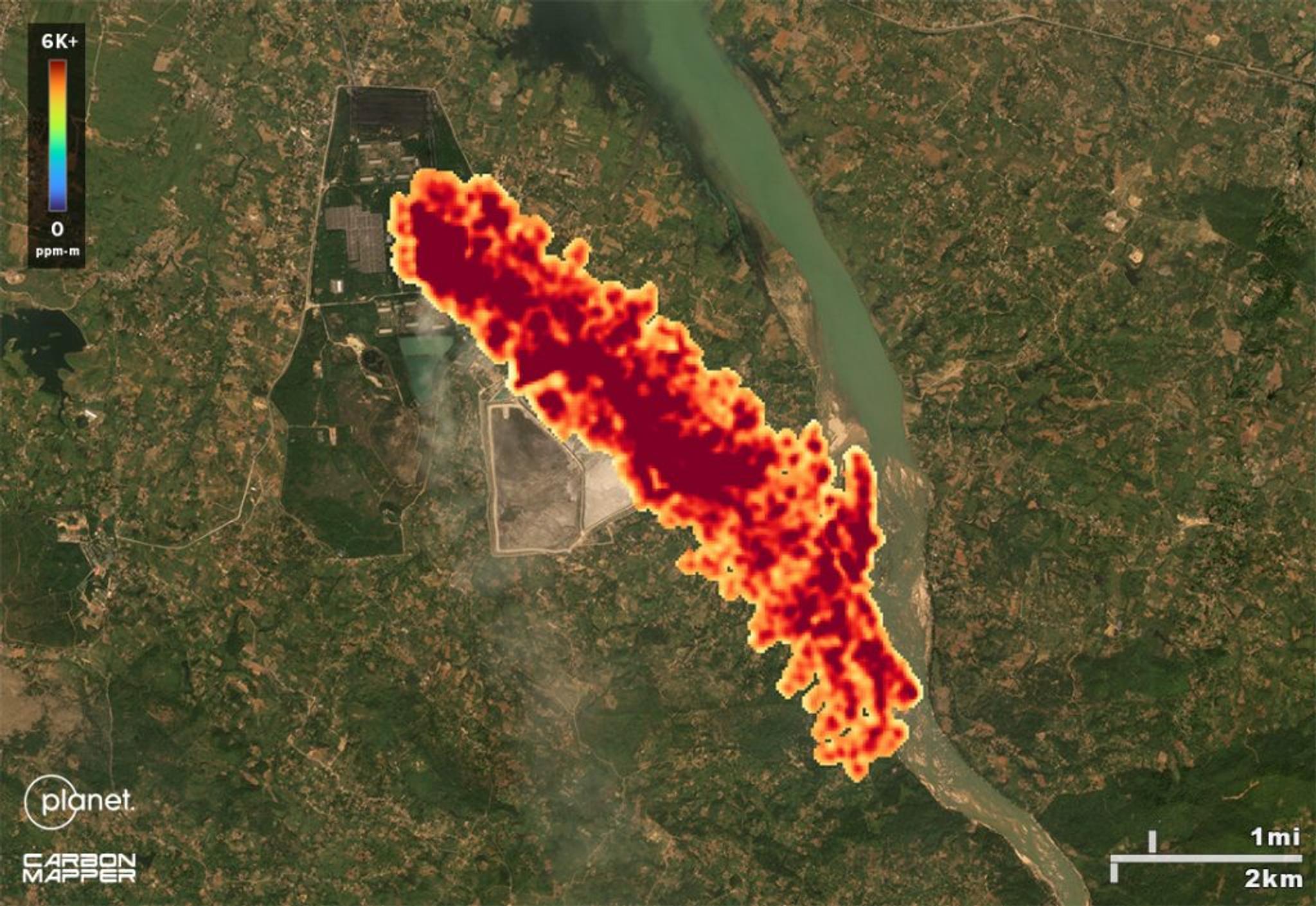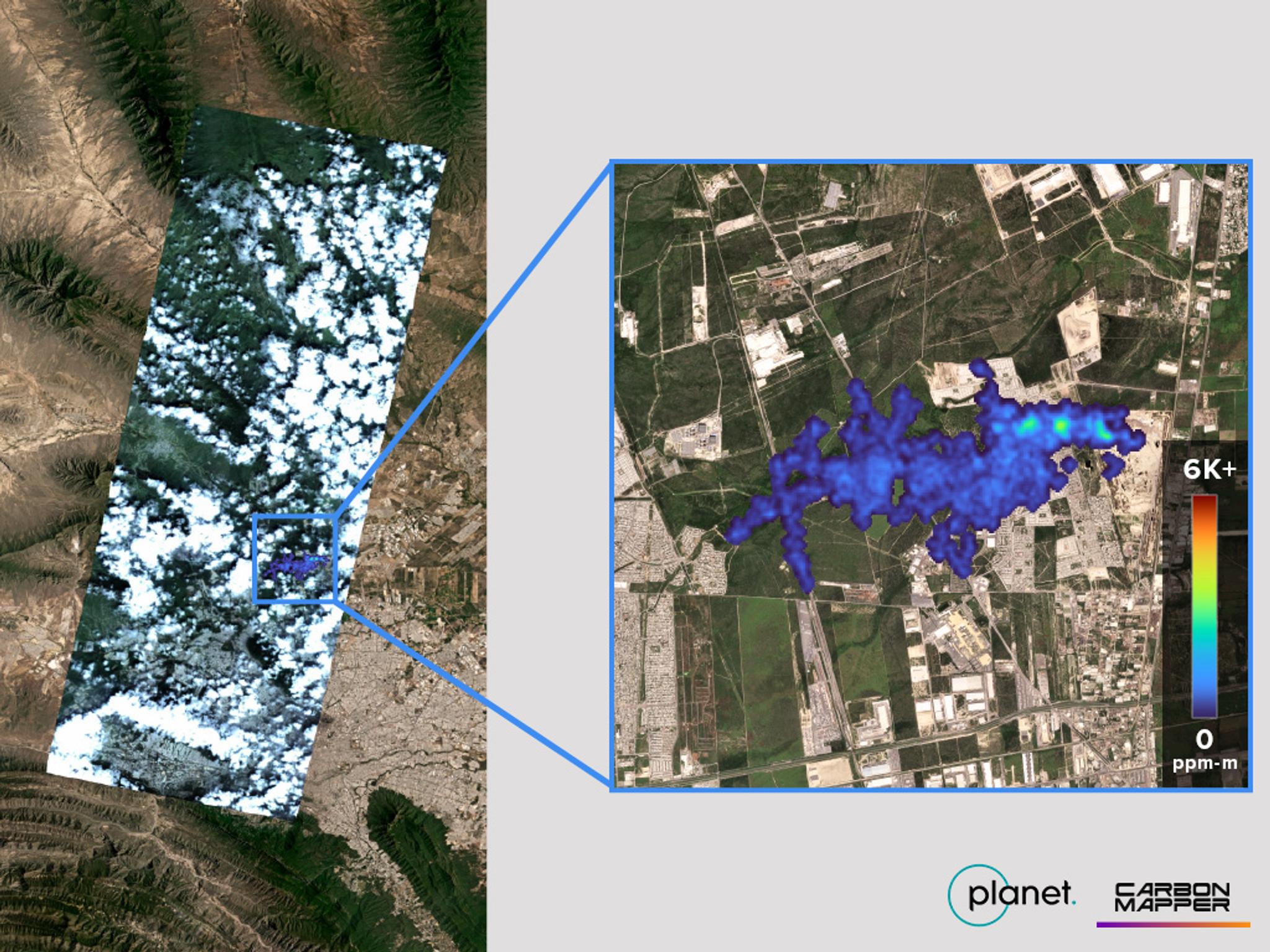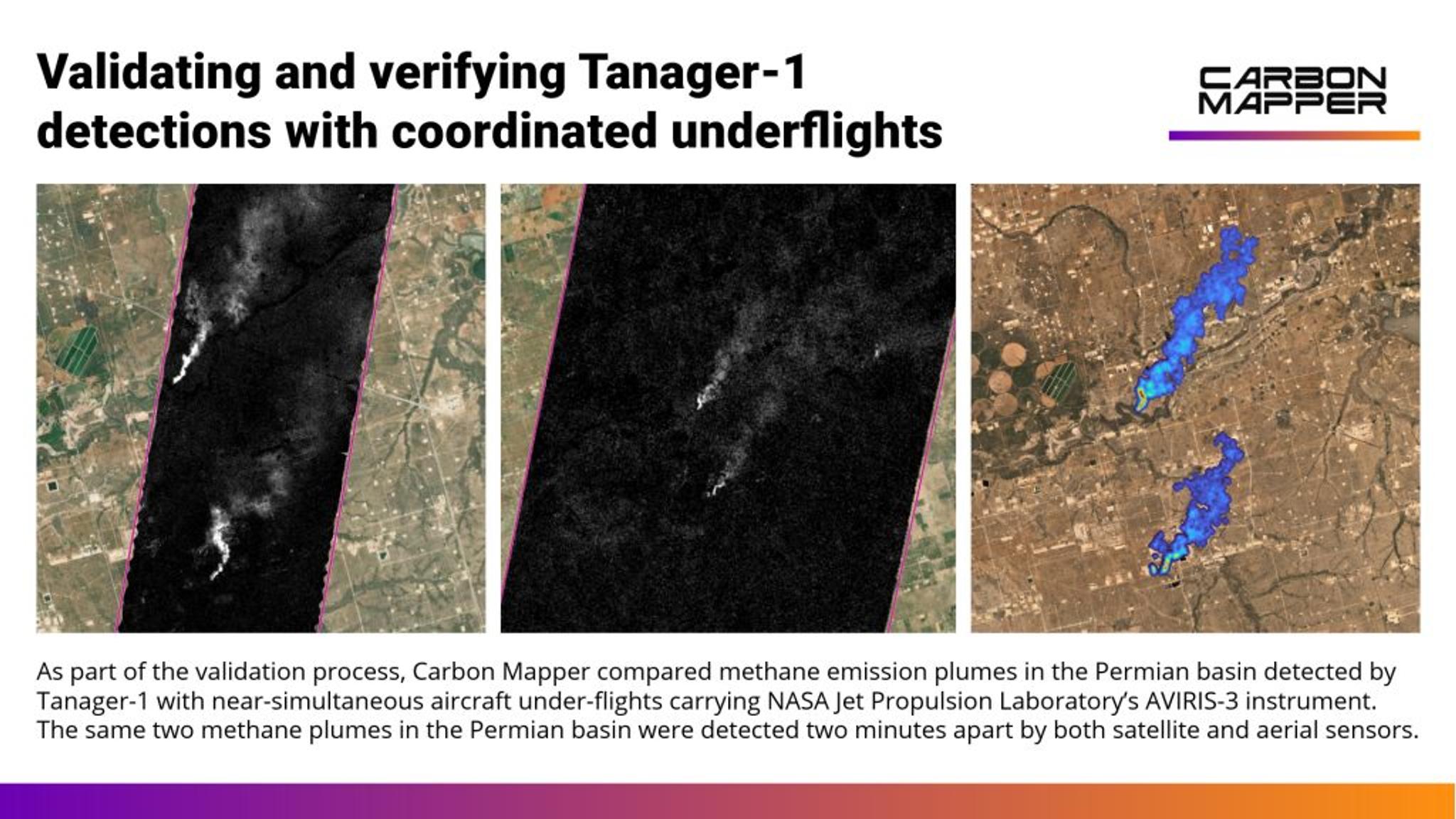Carbon Mapper data from the Tanager-1 satellite reveals methane and carbon dioxide super-emitter activity around the world

NewsTanager-1 is made possible by the Carbon Mapper Coalition, a philanthropically-funded effort to develop and deploy satellites designed to detect and track methane and CO2 super-emitters at a level of granularity needed to support direct mitigation action. Tanager-1 combines Planet’s cutting-edge agile aerospace and smallsat bus technology with the state-of-the-art imaging spectrometer design developed at NASA’s Jet Propulsion Laboratory (JPL).
###
PUBLISHED ARTICLE FROM CARBON MAPPER
Just three months after the Tanager-1 satellite launched into orbit, we have quickly hit many milestones that show how this state-of-the-art emissions-sensing satellite is performing, including our first mitigation success story!
The Tanager-1 satellite, built and operated by Planet Labs PBC with technology from NASA Jet Propulsion Laboratory (JPL), has quickly hit many of its expected milestones — starting with first light earlier this fall and the first emissions detections soon after.
During its commissioning phase, Tanager-1 is undergoing instrument calibration, data validation, and maneuvering into its operational orbit. Validation efforts include comparing methane emissions detected by Tanager-1 with those from coordinated under-flights with methane-sensing aircraft and controlled release testing where ground teams release precisely metered amounts of methane while the satellite images. Meanwhile, Tanager-1 has been busy orbiting the globe and delivering hundreds of preliminary observations from high-emitting sources across oil and gas, coal, waste and agriculture sectors.
Today, Carbon Mapper is excited to release over 300 initial detections of methane and carbon dioxide emissions from Tanager-1 to our data portal. These include waste emission plumes from landfills or dumps sites across North and South America, Northern Africa, the Middle East, Southern Europe and Asia — and fossil fuel emission plumes from major oil and gas basins and coal production across six continents. We anticipate refining these preliminary estimates in the coming months to account for any updates arising from calibration and validation efforts, and to better address variability in emissions.
Meanwhile, here are some of the early observations and capabilities the team is most excited about!
Increasing visibility of super-emitters across global oil and gas basins
Due to its relatively low detection limit, high spatial resolution, and wide area coverage, Tanager-1 is providing a growing understanding of super-emitter activity across entire sections of major oil and gas producing basins at unprecedented levels of granularity.

Carbon Mapper methane detections from Planet Labs’ Tanager-1 satellite show several methane plumes from oil and gas operations in a single observation over Syria on Oct. 4, 2024. The scene includes a mix of both small and large super-emitting sources, which demonstrates their prevalence in heavy oil- and gas-producing areas. The Tanager-1 satellite was built and is operated by Planet Labs PBC as part of the Carbon Mapper Coalition.
In a single satellite overpass of an oil and gas basin in Syria, Tanager-1 observed multiple large emission events from production facilities, revealing the prevalence of methane super-emitters in a region where much less is known about methane emissions and their sources when compared to more intensively studied areas, such as the Permian Basin, the highest producing oil field in the U.S.
During a single overpass on Oct. 4, a Tanager scene revealed 12 plumes, which make up 12,600 kilograms of methane per hour. Each hour that methane is emitted at this rate equals roughly the same CO2 emissions as driving 84 gas-powered cars for a year.
Another example is a scene captured over Turkmenistan, highlighting the extent of methane super-emitters in a region that has been observed many times before. Carbon Mapper’s preliminary emissions estimate of the 13 plumes observed is approximately 78 tons of methane per hour. This emissions rate is twice the average total methane emissions from the Los Angeles Basin. This scene showcases Tanager’s hyperspectral capabilities to capture clear images in coastal waters, where fine sediment can pose challenges to less sensitive instruments.

Thanks in part to satellite observations, Turkmenistan has over the past few years deepened its methane reduction efforts, joining the Global Methane Pledge in 2023. Observations like these can help it further refine and prioritize programs and policies aimed at tackling methane in the oil and gas sector. Tanager-1 observed this coastal region of Turkmenistan with a single image on Nov. 11, and Carbon Mapper’s preliminary emissions estimate of the plumes is approximately 78 tons of methane per hour.
These detections are a clear demonstration of how Tanager-1’s wide area coverage and high sensitivity can provide more visibility of emission sources globally — especially in regions that have not benefited from frequent observations by more sensitive sensors.
Identifying opportunities to address waste methane
It is estimated that waste is responsible for nearly 20% of human caused methane emissions globally, and Carbon Mapper studies have found that waste methane sources tend to be more persistent than their counterparts in the oil and gas sector. This sector clearly presents an outsized opportunity for near-term mitigation action. However, currently there is limited actionable information about the global waste sector, and many developing countries have little-to-no information about their waste emissions. Satellites like Tanager-1, are beginning to help fill those gaps and are proving to be important tools to quickly find large emissions events and help prioritize investments and mitigation solutions. This is especially relevant to countries participating in the Lowering Organic Waste Methane (LOW-Methane) initiative — a collaboration between international partners to cut methane emissions from the waste sector.
Observations from four landfills in Rio de Janeiro and São Paulo, Brazil, demonstrate the opportunity to reduce emissions. Carbon Mapper detected and quantified methane using Tanager-1 observations and found that emissions stemming from these four sites are equivalent to 7% of all solid waste methane emissions reported in Brazil's national greenhouse gas inventory. Addressing these waste sites, and other high-emissions sites around the country, could help Brazil prioritize and make meaningful progress toward its Global Methane Pledge targets.

An example of a mitigation opportunity near Rio de Janeiro, Brazil, where Carbon Mapper methane detections from Planet Labs’ Tanager-1 satellite show a large plume of methane from the Seropédica landfill on Sept. 29, with an estimated preliminary emissions rate of 2,836 kilograms per hour.
Growing our understanding of CO2 emissions from hard to measure sites
In addition to new Tanager data, Carbon Mapper is pleased to release emissions quantification for carbon dioxide (CO2) plumes detected by multiple sensors including NASA’s EMIT and various aircraft. The importance of addressing CO2 is well known, as it traps heat in the atmosphere for hundreds of years and has strong warming implications for the planet. However, we hope to share new insight, by providing CO2 emission quantification for large stationary sources. This will help decision makers quantify and track fossil fuel CO2 emissions at the scale of individual facilities, like power plants and refineries. It also ensures point source CO2 emissions data is available in places where no site level monitoring or public data exists.

Carbon Mapper detections from Planet Labs’ Tanager-1 satellite show CO2 from electricity generation in Singrauli, Madhya Pradesh, India, on Nov. 1. Carbon Mapper’s preliminary estimated source emission rate is 838,000 kilograms per hour of carbon dioxide. The Tanager-1 satellite was built and is operated by Planet Labs PBC as part of the Carbon Mapper Coalition.
Tanager’s unique technical capabilities
Carbon Mapper’s release of hundreds of methane and CO2 plume detections from Tanager-1 observations around the globe are an exciting early demonstration of the satellite’s unique capabilities — and just the tip of the iceberg in terms of what is possible as we expand the coverage and frequency of our observations.
Seeing around the clouds
Cloud cover has historically posed a significant barrier to observing surface emissions from space - particularly in the tropics. However, we’ve seen several early examples where Tanager-1’s high spatial resolution enabled Carbon Mapper to detect and quantify methane even in mostly cloudy scenes by spotting plumes through gaps between the clouds. This scene from Monterrey, Mexico, shows a large plume of methane stemming from a landfill that was spotted between a small (500 meter) gap between clouds.

Left - the Tanager scene shows a cloudy sky with a plume detectable between gaps in the clouds. Right - the Carbon Mapper plume shows methane emissions stemming from a landfill. The preliminary methane emissions estimate is approximately 2,546 kilograms of methane per hour.
Building trust in the data
As part of Tanager-1 calibration and validation efforts, we are evaluating our methane detection and quantification methods with a series of underflights with NASA’s Airborne Visible/Infrared Imaging Spectrometer (AVIRIS-3) that are coordinated to occur at same time as Tanager observations over various regions across the US. In the example below, the same two oil and gas methane plumes in the Permian Basin were detected two minutes apart by both satellite and aerial sensors. The coordinated aircraft underflights, together with ongoing controlled release testing (where a ground team releases precisely metered amounts of methane when the satellite is imaging overhead), provides empirical validation of our technology and analysis methods and is intended to build trust in Carbon Mapper’s emissions data.

As part of the validation process, Carbon Mapper compared methane emission plumes in the Permian basin detected by Tanager-1 with near-simultaneous aircraft under-flights carrying NASA Jet Propulsion Laboratory’s AVIRIS-3 instrument.
Levering satellite emissions data looking forward
In the coming months, Carbon Mapper will continue to scale up observations and make methane and CO2 data routinely accessible — including anticipated expanded Tanager-1 coverage and routine data releases after Tanager-1 completes its commissioning period. Carbon Mapper will also collaborate with complementary satellite programs — like the Environmental Defense Fund MethaneSAT — to provide data at different levels of granularity to advance societal understanding of methane sources worldwide, and work alongside other partners to translate this data into action through leading scientific expertise, stakeholder engagement, and decision useful insights for policymakers, harnessing the power of emissions transparency to deliver impact globally.

Ready to Get Started
Connect with a member of our Sales team. We'll help you find the right products and pricing for your needs.

